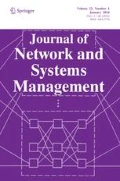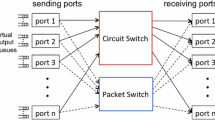Abstract
Several distributed real-time methods have beenproposed for restoration from single span failures indigital transport networks. These methods have thepotential to avoid user service outages due to such failures, if they operate quickly enough. Forexample, switched 64 kbps connections will not bedisconnected if the network can be restored before thetime at which calls in progress are dropped, typically 1-2 seconds after a failure. However, it willbe difficult to achieve the goal of sub-secondrestoration if cross-connects cannot operate crosspointsquickly enough, either due to large workloads during a restoration response, or because ofimplementation choices such as testing eachcross-connection while in the midst of a serious outage.The results in this paper demonstrate that it can beuseful to pre-operate selected cross-points between thespare links of a mesh-restorable network before anyfailure has occurred, putting the network into astatistically optimal state of readiness. When a failure occurs, some of the preconfigured restorationpath bundles can be used immediately. If morerestoration paths are needed, they can be obtained by areal-time restoration process. The first advantage of preconfiguration is that the number ofcross-connection operations may be greatly reduced oreliminated for a portion of the affected traffic. Thiswill reduce restoration time significantly. Secondly, after utilizing preconfigured restorationpaths, the workload of a real-time restoration processwill be lower because it will be searching for fewerpaths. This paper demonstrates that preconfiguration can supply a significant proportion of thereplacement capacity required after a span failure. Theresults are obtained through integerprogramming.
Similar content being viewed by others
REFERENCES
W. D. Grover, B. D. Venables, M. H. MacGregor, and J. H. Sandham, Development and performance verification of a distributed asynchronous protocol for real-time network restoration, IEEE J. on Selected Areas in Communication, Vol. 9, No.1, pp. 112–125, 1991.
H. Sakauchi, Y. Nishimura, and S. Hasegawa, A self-healing network with economical spare-channel assignment, Proc. IEEE Globecom ’91, pp. 438–443, 1991.
C. H. Yang and S. Hasegawa, FITNESS: A failure immunization technology for network service survivability, Proc. IEEE Globecom ’88, pp. 1549–1554, 1988.
W. D. Grover, Distributed restoration of the transport network, Telecommunications Network Management: Into the 21st Century, IEEE Press, New York, pp. 337–417, 1994.
C. W. Chao, P. M. Dollard, J. E. Weythman, L. T. Nguyen, and H. Eslambolchi, FASTAR—A robust system for fast DS3 restoration, Proc. IEEE Globecom ’91, pp. 1396–1400, 1991.
SR-NWT-002514, Digital Cross-Connect Systems in Transport Network Survivability, Issue 1, Bellcore, January, 1993.
T.-H. Wu, H. Kobrinski, D. Ghosal, and T. V. Lakshman, A service restoration time study for distributed control SONET digital cross-connect system self-healing networks, Proc. ICC’93, pp. 893–899, 1993.
W. D. Grover and M. H. MacGregor, On the potential for spare capacity preconnection to reduce cross-connection workloads in mesh-restorable networks, Electronics Letters, Vol. 30, No.3, pp. 194–195, Feb. 3, 1994.
M. Herzberg and S. Bye, An optimal spare-capacity assignment model for survivable networks with hop limits, Proc. IEEE Globecom ’94, pp. 1601–1607, 1994.
W. D. Grover and M. H. MacGregor, Method for Preconfiguring a Network to Withstand Anticipated Failures, U.S. Patent Application 08/551,709, November 1, 1995.
Rights and permissions
About this article
Cite this article
Macgregor, M.H., Grover, W.D. & Ryhorchuk, K. Optimal Spare Capacity Preconfiguration for Faster Restoration of Mesh Networks. Journal of Network and Systems Management 5, 159–171 (1997). https://doi.org/10.1023/A:1018770811352
Issue Date:
DOI: https://doi.org/10.1023/A:1018770811352




